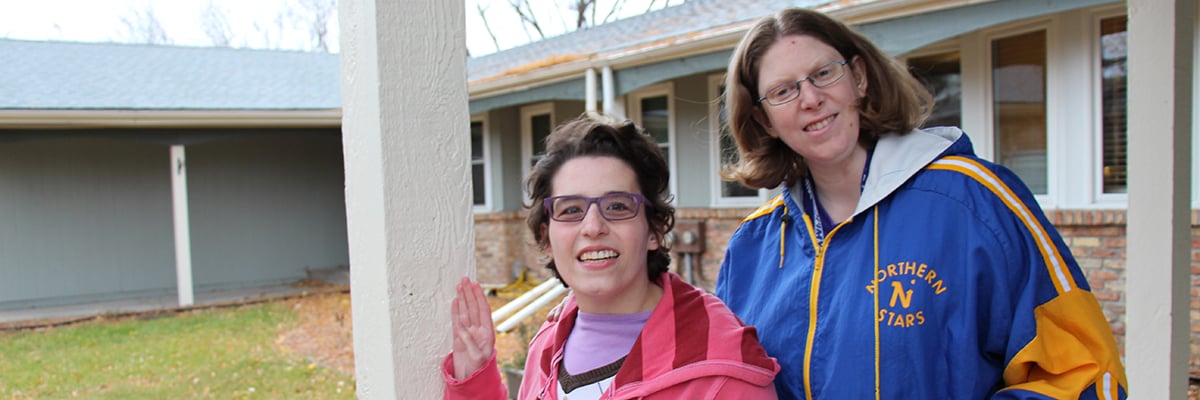
Housing Options
Remember, it will take time, energy, and creativity to come up with a plan that fits your young adult’s individual needs. Housing options generally fall into the following categories:
- Family’s, friend’s, or relative’s home
- A person’s own home, townhome, condominium or apartment rental or ownership
- Community Residential Settings: adult foster care, group homes
- Institutions
- Intermediate Care Facility for persons with developmental disabilities (ICF/DD)
- Nursing homes
- Cooperative housing
- Co-housing
Family’s, Friend’s, or Relative’s Home
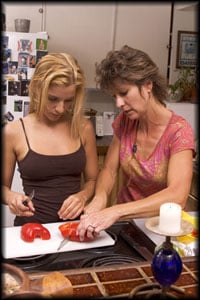
A person with a disability may choose to live at home with his or her family for a variety of reasons. It may be a family tradition for youth to live at home until they have their own family. Family members may need one another for financial support. Some young adults may choose to live at home to save money. Still others live with their families because it is where they receive the support they need to manage their lives.
Young adults should learn to be as responsible and independent as possible, even if they live at home. All members of the family should contribute to the household. Families may need to talk about household rules and each member’s responsibilities. It is fair to expect a young person who is working and receiving a Supplemental Security Income (SSI) check to share in the cost of food and household expenses. SSI rules can be complicated. For instance, people who live at home with their family will have their SSI check reduced by approximately one-third. However, their SSI check will not be reduced if parents notify the Social Security Administration they are charging their young adultir fair share for room and board.
“A Person’s Own Home”
Single-Family Home, Townhome, Condominium, or Apartment Rental or Ownership
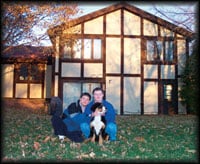
Greater opportunities now exist for people with disabilities to rent or own apartments, condos, townhomes, or single-family homes, and receive the services and supports they need in the location of their choice.
As discussed previously, the Olmstead Decision supports the concept that services and supports should be provided in the most integrated setting possible. We are in a transition time from the moratorium on corporate adult foster care to “a person’s own home”. In “a person’s own home” the person receives services from a licensed provider that does not have a financial interest or own the housing. If more than two individuals independently choose to live together and are all receiving Home and Community-Based Services, the Minnesota Department of Human Services (DHS) will work with your young adult’s team to determine if the setting requires a license. In addition, system level changes to Minnesota’s Home and Community-Based waivers services called “Waiver Reimagine” now more effectively meet the specific needs of the person based on the setting or housing option the person is living in. Rent assistance, called Minnesota Supplemental Aid (MSA) Housing Assistance, is available to those that qualify and adds to the flexibility and choices people have.
More information on “a person’s own home” can be found on the Minnesota Department of Human Services, Community-Based Services Manual.
For example, the person with the disability or their parents or guardians may rent or purchase an apartment, condo, townhome, or home. They can then hire their own staff through various funding sources, including Home and Community-Based Waivers, home care, Consumer Directed Services, Personal Care Attendants, paid or unpaid natural supports, or a contract with a housing provider for services. The mixing and matching of services within service menus allows people with disabilities the ultimate freedom to hire and fire their staff or providers.
New individualized housing options may include:
- Monitoring (“Smart Home”) technology to augment staff allows for increased privacy and monitors the safety of a person with a disability
- Scattered-site apartment or condo within a market property that includes people with and without disabilities in an apartment or condo complex. The provider has separate apartments or condos for on-site service staff as specified by a person’s Coordinated Services and Supports Plan (CSSP).
- Consumer or parent-owned housing where live-in staff or shift staff is hired by the person with a disability or their parent or guardian. Unique arrangements may be used to augment staffing using natural supports, which may involve parents, siblings, community members, or volunteers. Minnesota Supplemental Aid (MSA) Housing Assistance supplement for room and board may be accessed by individuals relocating to the community from an institution or receiving State Plan Services, Home and Community-Based Waivers (HCBS), or Self-Directed Supports.
Renting and owning have advantages and disadvantages. Your young adult’s financial resources may determine whether they want to consider renting or owning their own home. For some people, renting is a better choice. Some renters prefer the flexibility to be mobile and to be able to make important lifestyle changes more easily, such as those necessary when taking a new job or entering a relationship. Other renters like the fact that they are not fully responsible for maintenance. Some people may be renters due to their financial situation. Subsidized rental housing is available to people with disabilities who have limited financial resources. This option limits the amount paid for housing (including utilities) to 30 percent of income. For more information see the “Available Funding Sources?” section.
If your young adult is able to afford it, home ownership has several advantages over renting. Being a homeowner can closely connect a person to his or her community. A home of one’s own can provide a sense of permanency. In addition, people who own their homes often have more living space and more freedom to change their property as they like. Housing payments are relatively stable. Owning a home also means that people are more likely to become involved in their community because they are likely to live there long term.
However, there can be significant costs in securing a home loan and down payment. A person who owns a home is responsible for its maintenance and repairs. He or she will have to determine if physical modifications are needed and available, whether it is better to live alone or with others, and whether public transportation, if needed, is available nearby. The answers to these questions will help determine where the person lives.
People with disabilities should also be aware of community resources that may be helpful in finding a place to live. For example, many cities offer first time home-buyers money, and many agencies offer “Home Stretch” training. Financial assistance may be available from community land trusts (such as City of Lakes in the Twin Cities metro area). Check your city’s website for more information on land trusts and home ownership resources.
Additional resources
- Housing Benefits 101
A tool that can help your young adult with additional information about exploring housing goals, learning more about housing options, learning more about services and programs to help your young adult’s current living situation, and a tool to create a plan to reach your goals. - Multi County Collaboration — Individualized Housing Options Resource Guide for Persons with Disabilities, 2017
- Minnesota Department of Human Services — Community-Based Services Manual
- 20 Revealing Questions that Every Renter Should Ask
Home Ownership
- Minnesota Housing Finance Agency
- Minnesota Home Ownership Center
- Home Ownership Opportunity Alliance
- Refinance Mortgage Guide for People with Disabilities
Housing Search Engines
Co-Housing
 Co-housing is a growing movement in the United States. Co-housing is an intentional community of private homes clustered around shared space. Each attached or single family home has traditional amenities, including a private kitchen. Shared spaces typically feature a common house, which may include a large kitchen and dining area, laundry, and recreational spaces. Shared outdoor space may include parking, walkways, open space, and gardens. Neighbors also share resources like tools and lawn mowers. Although households have independent incomes and private lives, the co-housing philosophy is based on traditional community living where neighbors and residents can share some of the day-to-day responsibilities of family living. Co-housing creates cross-generational communities that invite a variety of families and single people to participate in the planning, design, and ongoing management of the development. Some communities may decide to share responsibilities, such as childcare or eldercare or may plan to dine together on certain days of the week. The legal structure is typically that of a homeowners association, condo association, or housing cooperative.
Co-housing is a growing movement in the United States. Co-housing is an intentional community of private homes clustered around shared space. Each attached or single family home has traditional amenities, including a private kitchen. Shared spaces typically feature a common house, which may include a large kitchen and dining area, laundry, and recreational spaces. Shared outdoor space may include parking, walkways, open space, and gardens. Neighbors also share resources like tools and lawn mowers. Although households have independent incomes and private lives, the co-housing philosophy is based on traditional community living where neighbors and residents can share some of the day-to-day responsibilities of family living. Co-housing creates cross-generational communities that invite a variety of families and single people to participate in the planning, design, and ongoing management of the development. Some communities may decide to share responsibilities, such as childcare or eldercare or may plan to dine together on certain days of the week. The legal structure is typically that of a homeowners association, condo association, or housing cooperative.
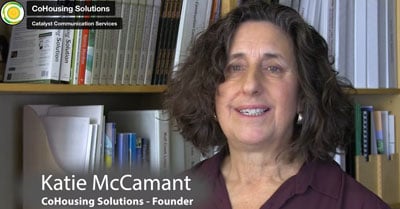
Additional Resources
- What is CoHousing?
- CoHousing Solutions
CoHousing Solutions provides development consulting services to help create sustainable neighborhoods, creating dozens of successful, award-winning communities. Its newest venture involves training cohousing entrepreneurs through its year-long 500 Communities Program. -
Twin Cities Cohousing Network – Catalyzing Cohousing in Minnesota
TCCN’s mission is to provide education, outreach, and engagement with individuals, families, and organizations, to advance the development of high-quality sustainable cohousing communities in the Greater Twin Cities area. A list of co-housing organizations in the Twin Cities is included. - CoHousing Association of the US
Cooperative Housing
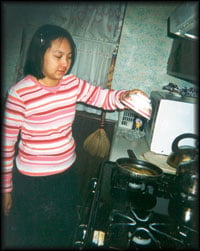
Individuals interested in home ownership, for personal and economic benefits and also for the social benefits a community can offer, may organize to form a kind of corporation called a cooperative or co-op. Members don’t own their individual units; rather, they own one share in the cooperative and have one vote at general membership meetings. Members sell their share back when they move out. After co-op members elect a board of directors, the board may hire a property manager, contract for needed services, or decide that members will manage the services on a volunteer basis. The co-op is eligible for financial assistance or low-cost loans from the government. Shared leadership and responsibilities, including rules and regulations of the co-op, are important factors to consider before choosing to participate in a housing co-op. Your young adult may want to also look at the activities and interests of the other members for compatibility.
Resources
- National Association of Housing Cooperatives
- Senior Coop Models in Minnesota
- Mortgage Insurance for Cooperative Housing, Section 213
Section 213 insures mortgage loans to facilitate the construction, substantial rehabilitation, and purchase of cooperative housing projects. Each member shares in the ownership of the whole project with the exclusive right to occupy a specific unit and to participate in project operations through the purchase of stock.
Community Residential Settings

“Community Residential Settings” is the new terminology that includes Adult Foster Care commonly known as group homes. The informal term “group home” does not refer to a specific state license or registered setting. Community Residential Settings are licensed and registered with the Minnesota Department of Human Services (DHS) to provide specialized services to people with disabilities through varying levels of care. Community Residential Settings provide sleeping accommodations and services for one to four adults (five adults, if the residents are elderly). They provide 24-hour continuous care plus support, structure, nurturance, and control toward achieving individualized goals within a family home environment. Some caregivers own and live in the homes they provide care in, while others are employees paid to live on site. When the caregiver owns the home, it is called Family Adult Foster Care. When the caregivers are employees, it is called Corporate Adult Foster Care. Unlike group homes and Intermediate Care Facility for Developmental Disabilities (ICF/DD), a community residential setting is less formal and is licensed under the Department of Human Services.
As discussed previously Olmstead supports the concept that services and supports should be provided to people with disabilities in the most integrated setting possible. States have been directed to comply with the new Home and Community-Based Services and Settings rule. Minnesota received final approval of its Statewide Transition Plan (STP) by the Centers for Medicare and Medicaid Services (CMS) on February 8, 2019.
All providers had to go through an attestation process for all settings that group people who receive Home and Community Based Settings.
- The “attestation process” includes a framework consisting of three phases: assessment, validation and remediation.
- Guidance provided by the Minnesota Department of Human Services (MN DHS) to assist providers with the necessary steps to reach compliance include helpful tips tools and resources, as well as “assessment” and “validation” (proof) of documentation from the provider, audits, on-site visits and a review of a persons with a disabilities experiences of the settings and services.
- “Remediation” or steps the provider still needs to complete for specific sites, will be completed to bring their settings into compliance.
- If providers cannot complete these requirements, and settings are not “presumed to be Home and Community-Based” they will need to go through “heightened scrutiny”, meaning settings must be submitted to Centers for Medicaid (CMS) for approval.
The final approval was granted to Minnesota after they worked collaboratively with Centers for Medicare & Medicaid Services (CMS) on the above attestation process with the understanding that they have additional processes. Those are to continue to review the progress of the proposed milestones, address challenges during the remediation process, and address the sites that are under heightened scrutiny, with the expectation they reach compliance by March 2023.
Resources
- MN.gov — Minnesota’s HCBS Transition Plan
The new definition considers a person’s experience and outcomes in addition to a setting’s location, geography or physical characteristics.
Housing and services providers that are lease holders must now work with your young adult with a disability, their legal guardian(s) where appropriate, and the case manager, to develop a plan to transition the lease from the provider to the person. This process cannot take longer than two years unless the Minnesota Department of Human Services approves an extension. Your young adult may choose to include others in the planning process, such as the housing service provider and landlord.
According to the Minnesota Department of Human Services (DHS), community residential care services provide “supportive services” and “health-related services.” Supportive services mean providing up to 24-hour supervision and oversight. When a person is living in a Community Residential Setting, the Coordinated Service and Support Plan (CSSP) must indicate what services the residential care provider will furnish. These services cannot be duplicated by other state plans or by waivered services.
Supportive services include:
- Transportation, when provided by the residential care home
- Socialization, which is part of the plan of care that establishes specific goals and outcomes
- Assistance in setting up a person’s meetings, appointments, and arranging medical and social services
- Assistance with personal laundry, such as carrying the person’s laundry to the laundry room
Health-related services are limited to minimal assistance with:
- Dressing, grooming, and bathing
- Providing reminders to residents to take self-administered medications or providing storage for medications, if requested
It is important for parents to be informed and know which questions to ask a residential service provider. Some agencies may work more effectively to include individualized supports in the care plan, while others may try to fit needs into a prescribed set of offerings. Every family must realistically decide how much time and energy they are willing and able to commit. It is best if agencies have committed and caring leaders, have a clear set of principles that guide their work, be open to change, and have a clear understanding that services need to be individualized.
Some questions families may want to ask about residential housing include:
- Who owns the residence?
- What are the abilities and disabilities of the people living here?
- How many people live here?
- Is the degree of supervision and freedom person-centered?
- What are the “house rules?”
- What are the qualifications and talents of the staff?
- What is the staff to resident ratio?
- Does the staff live here, rotate, or work shifts?
- What is the staff turnover rate?
- What kind of training does the staff receive?
Resources
- University of Minnesota — “Questions to Ask Residential Providers”
Support for families and persons with disabilities in selecting residential service providers. Its contents are based upon information family members have indicated is important to consider when making decisions about which agencies are best suited to meet the support needs of persons with disabilities.
- MN DHS HB101 Places
- Metro Crisis Coordination Program (MCCP) — Residential Openings List
Provides families a means to search for openings in current residential settings.
Institutions
Other Group Home Settings
Housing settings that include services where seniors or people with disabilities live in the same building are also sometimes called “group homes.” Group homes may include boarding and lodging establishments, non-certified boarding care homes, and housing- with-services establishments, sometimes called “assisted living.”
Licensing requirements and funding streams define the differences among these options and are overseen by the Department of Health (MDH). Housing under these categories may include five or more people who may have individual or shared bedrooms, depending on the facility. Living rooms, dining rooms, or cafeterias, are shared spaces.
Intermediate Care Facilities
An Intermediate Care Facility for Persons with Developmental Disabilities (ICF/DD) is a residential facility licensed to provide services to people who have developmental disabilities or a related condition that requires a 24-hour plan of care to assure their health, safety, and well-being. Residents are usually unable to apply learned skills without ongoing supervision and cannot take care of their personal needs by themselves. According to federal law, individuals with developmental disabilities “must have substantial limitations in their present level of functioning, manifested as significantly below average intellectual functioning and demonstrated deficits in adaptive behavior that appear before their 22nd birthday.” ICF/DD’s can serve from four to 64 people. Eligibility for ICF/DD services is determined through a screening process through the county.
An Intermediate Care Facility for Persons with Developmental Disabilities (ICF/DD) must:
- Provide a continuous active treatment program that is based on the needs, preferences, and goals of the person
- Be consistent with the principles of the least restrictive environment and self-determination
- Include opportunities to participate in the community
- Include functional skill development and opportunities for the development of decision-making skills
Since Minnesota’s Olmstead Plan identifies increasing the number of people with disabilities to live in the most integrated housing of their choice, the state has seen a shift from those living ICF/DD’s into housing of their choice.
Nursing Homes
Nursing homes are community-based settings that provide a 24- hour plan of care for individuals who need nursing care. Nursing homes should be considered transitional facilities for adults and not permanent residences. By federal law, a residence of over 16 beds is considered an institution. Since laws have been passed to de- institutionalize settings, individuals with developmental disabilities or mental illness should not be in nursing homes with individuals over the age of 65. State and federal money pays for lodging expenses if counties place individuals in smaller settings, such as group homes of four or fewer people.
Continued ...
